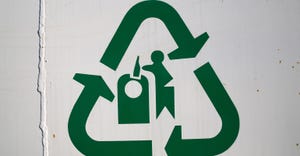October 1, 2005
Michael Fickes
FOR THE LAST MONTH or so, George Dreckmann has been responding to nearly 100 phone calls and 50 e-mails per day. As the recycling coordinator for Madison, Wis., and its 218,000 residents, Dreckmann has been overseeing the city's conversion from dual-stream to single-stream recycling.
Recycling is mandatory in Madison, and between 95 and 98 percent of the city's 64,000 households participate, according to the city. With so many recycling households, Dreckmann's voice-mail box and e-mail inboxes have been stuffed full of messages from residents with questions. “You think you can manage this kind of conversion?” chuckles Dreckmann. “It's like herding cats.”
For the two weeks leading up to the Sept. 12 starting date for single-stream recycling collections, Dreckmann spent virtually all of his time working with residents who have had cart delivery problems. Some residents had ordered one size cart and received another. Others had turned in order forms, either on time or late, and received no cart.
“If you can avoid offering a choice of cart sizes, do it,” says Dreckmann. “It takes a lot of staff time and staff expense to administer our system, which gives residents a choice of three cart sizes. It also creates a lot of angst among staffers.”
Many collection operations have or are moving to single-stream recycling, a system in which residents put all their recyclables together in one container instead of having to separate them for collection. Advocates of single-stream recycling say it offers the benefits of lower curbside collection costs and increased recyclables recovery.
Studying Single Stream
A 2004 study published by the Washington-based American Forest and Paper Association (AFPA) — which opposes single-stream recycling because of concerns about contamination and increased processing costs — says the technique reduces curbside collection costs by $10 to $20 per ton. Industry observers attribute the lower collection costs to having to own less equipment. For example, single compartment trucks cost less to buy and operate since the vehicles can run either refuse or recycling routes.
The study — titled “Paper Recycling: Quality is Key to Long-term Success” and prepared by Jaakko Poyry Consulting, Tarrytown, N.Y., and Skumatz Economic Research Associates, Superior, Colo. — estimates that single-stream recycling recovers 1 to 3 percent more recyclables than source-separated collection. Industry observers note that fewer sorting requirements may lead regular recyclers to put out more recyclables and persuade non-recyclers to give the simpler system a try.
However, the money haulers save has to be spent by processors and paper mills. Processors must separate the co-mingled recyclables, which increases their expenses. Also, single-stream recycling may further contaminate the recyclables and lower the prices that material recovery facilities (MRFs) can fetch for their products. The AFPA study pegs the increased material recovery costs at $5 to $15 per ton. Further along the chain, contamination increases mill processing costs by $5 to $13 per ton, they say.
The Jaakko Poyry-Skumatz research found that single-stream recycling, from collection through manufacturing, increases the average net cost by $3 per ton — which will be paid by paper mills and product manufacturers and ultimately consumers.
But the haulers will save — eventually. First, however, they must ante up the initial costs, which includes buying new carts and possibly collection vehicles. Programs to educate residents must be paid for, as well. If the hauler operates or contracts for recycling processing services, those costs will rise too, since processors will now have to separate the materials. Nevertheless, the savings garnered during collection should leave most municipalities with a net benefit, the AFPA study says.
In the end, single-stream advocates say, the savings on collection and the capture of increased materials are so dramatic that processors and paper mills opposed to the change probably won't be able to slow the trend toward single-stream recycling.
In stark contrast to the AFPA study, one private contractor notes a substantial increase in single-stream recovery rates. “We have seen substantially higher recovery rates associated with programs that collect single-stream recycling,” says Ted Siegler, principal with Bellfonte, Pa.-based DMS Environmental Services. “There are many variables, but we say generally that you would expect somewhere in the range of a 10 percent to 20 percent increase in the amount of recycling materials set out by residents with a single-stream system.”
Automated Trucks Drove Decision
In addition to potentially collecting more recyclables, Dreckmann says Madison's decision was primarily fueled by the city's determination to switch to automated collection trucks.
“Our biggest concern is controlling overall collection system costs,” Dreckmann says. “We decided to go to single-stream recycling, not so much because single stream is good, but because it will enable us to switch to an automated collection system that will improve productivity and reduce on-the-job injuries and worker's compensation costs. We did the math, and it showed that an automated collection system will lower collection costs.”
In calculating the economic impact of the change, Madison balanced the city's projected savings from single-stream recycling against increased fees that MRFs would charge to sort single-stream loads. “This worked out marginally in our favor,” Dreckmann says. “But when we factored in changing over to automated collection trucks, the savings estimates grew tremendously.”
Madison's approach to starting single-stream is different than many cities that often begin by converting its refuse fleet to automated trucks and then discovering that the vehicles also can be used for recycling pick-ups. Madison, however, began looking at single stream when its contract with a processor was coming to an end. “Our 15-year recycling processing contract was coming up for renewal, and that made it an ideal time for us to look at single stream,” Dreckmann says. “In addition, one-third of our recycling fleet had come due to be replaced.”
Madison's recycling trucks have two compartments, one for paper and one for product containers. They are impractical for trash collection, so the city must maintain separate refuse and recycling fleets, as well as separate back-up trucks for each fleet.
By buying automated single compartment trucks that can be used for both recycling and regular trash collection, the city will immediately benefit. Madison believes the trucks will increase productivity and reduce the number of vehicles it needs for its solid waste operations by about half a dozen.
Buying Trucks
What refuse trucks should a city buy when it changes to automated equipment for both refuse and single-stream recycling collections? Initially, Madison is sampling trucks to determine which ones it will ultimately purchase.
“We drove our demo truck around our parking lot and picked up some empty sample carts,” Dreckmann says.
The demonstration problem was resolved by the fact that Madison had decided to start its conversion with its smaller recycling fleet. “We bought 11 trucks for recycling, from different manufacturers,” Dreckmann says. “Our idea is to get field experience for our drivers with several makes of trucks. Then when it comes time to [replace] refuse trucks, we'll have the information we need to make better buying decisions.” The Madison recycling fleet includes automated trucks from Bridgeport, Texas-based Bridgeport; Chattanooga, Tenn.-based Heil, Dodge Center, Minn.-based McNeilus and Appleton, Wis.-based Wittke, now integrated into the Leach line.
The switch to automated single stream recycling required Madison to purchase about $4 million in equipment, more than $2 million for carts and less than $2 million for trucks. The city expects to spend another $6 million to purchase 64,000 carts for refuse customers and 20 automated trucks for trash collection over the next few years.
Additional expenses include retrofitting a handful of existing side-loader and rear-loader trucks with cart tippers, using them as back-ups. “Every day, we send out at least two trucks with cart tippers to service dead-ends, alleys and one-way streets,” Dreckmann says. “Our semi-automated trucks also serve apartment buildings where we collect trash and recycling.”
Madison also has purchased FleetRoute from Fairfax, Va.-based Gershman, Brickner, Bratton to create new routes for its slimmed-down fleet, according to Dreckmann.
The MRF Effect
The shift to single stream also creates equipment and design challenges for MRFs that must now separate recyclables. The new facilities will be larger and more expensive to build, says Nathiel Egosi, president of RRT Design and Construction, a Melville, N.Y., based firm that builds MRFs. He says the chief difference between the old and new facilities comes at the front end, where a line of in-feed conveyors, a pre-sorting station and a series of screens will be needed to handle the new separation process.
“After the paper and containers are separated, the remaining part of the plant is similar,” Egosi says. “Paper is sorted into grades and baled. Containers are sorted by materials and baled — all but glass, which typically goes into bunkers or downstream processes.”
It occasionally makes sense to convert existing dual-stream MRFs to single-stream processing, Egosi adds. “The reason to explore conversion is that so much of an existing facility is useable,” he says. “Major conversion costs include modifications to the building to accommodate new equipment. In most cases, there will also be foundation work, new pits, perhaps an addition to the building and increased utility provisions.”
As haulers develop their plans to switch to single-stream recycling, one issue is the same for everyone: teaching residents how to use the new system. That is easier said than done. Consider, for example, the misunderstandings that have been created by the phrase “single stream.”
“It is important for municipalities to make it clear to residents that single stream is a system for recyclables and not for both recyclables and garbage and not for green waste,” Egosi says. “Public education needs to become more aggressive and better explain the single-stream system and its benefits. Remember, we have educated people for years on how to put recyclables into a dual-stream system. Today, years later, we're telling them something different. People won't adapt quickly to this without an aggressive educational program.”
And, as anyone in this business knows, without the public's cooperation, even the best equipment working in well-designed systems will not make for a successful program.
Mike Fickes is Waste Age's business editor.
You May Also Like


